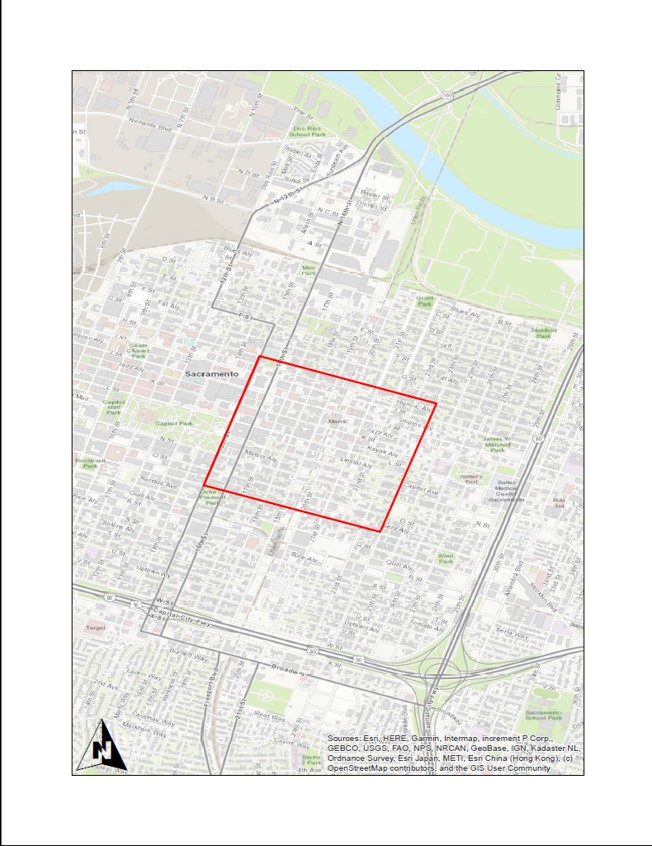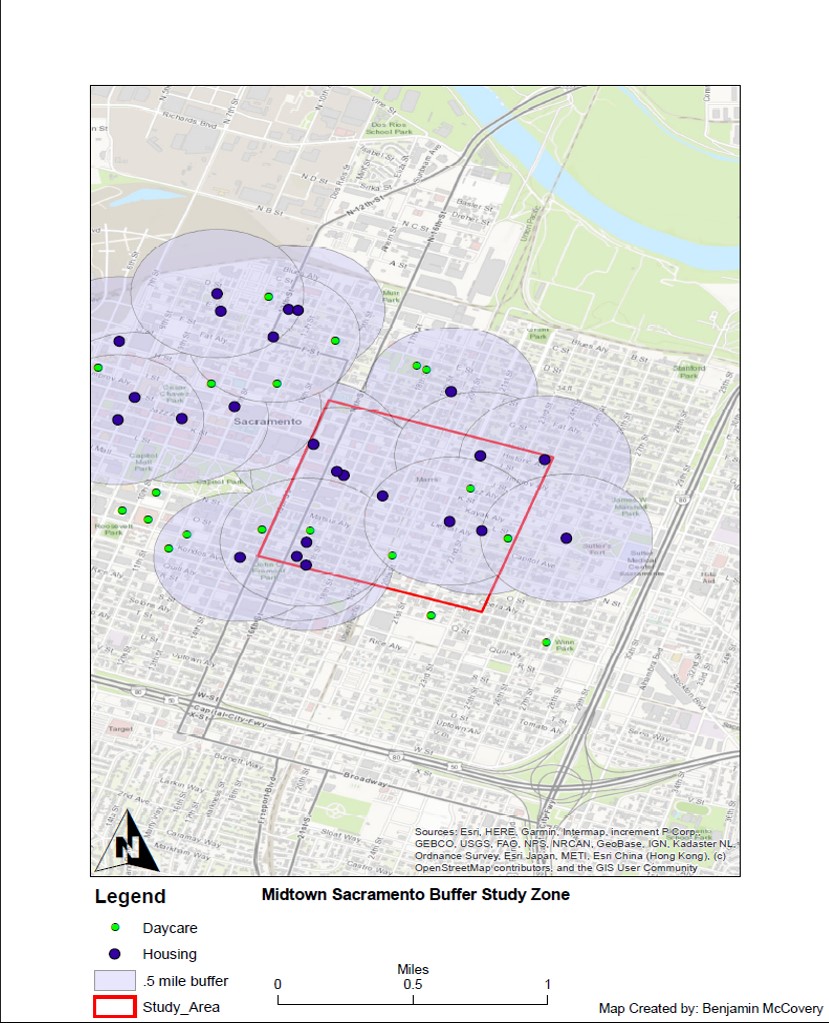Title
Low Income Housing and Child Care in Midtown Sacramento
Author Information
Benjamin McCovery
American River College, Geography 350: Data Acquisition in GIS; Fall 2019
Contact Information (ben_mccovery@yahoo.com)
Abstract
The City of Sacramento is a small but bustling city and is the Capitol of California. This exercise was created to determine adequate child care sufficient to support Low Income Housing Credit recipients in navigating Sacramento's housing crisis. Using ArcMap and buffer zones around Geographic points representing Low Income Housing and Day Care Centers, the results showed sufficient child care options outside of a Cost Analysis Normalization.
Introduction
The City of Sacramento is currently experiencing a housing crisis (1) on a large scale. Besides not having enough units for the number of California residents (2); the types of units being offered such as such as those that qualify for the Federal Low-Income Housing Tax Credit (LIHTC) and Section 8 housing are critically low (3). The need for more home is being built is one part of the solution but a large hurdle to rentership is childcare. Renters often spend an equivalent amount on childcare compared to how much they pay in rent forcing many families into at risk situations (4). Much like housing, the types and quantity of childcare are desperately needed to alleviate rising market prices and ease the burden on lower income families.
For my project I want to create a map of midtown that shows how LIHTC Housing overlaps with childcare in Downtown Sacramento in order to highlight the critical areas where both are needed to combat skyrocketing costs of either entity. I will use tools like Buffer in ArcMap to show these areas. My method of gathering locational data will include GPS marking child care sites and housing sites. I will use imagery from google earth and an appropriate Esri Base map.
Background
Title 22, Div 12, Chap 1, Art 1-2 - Child Care Centers [From the State of California Guidelines](5):
"Child Care Center" or "Day Care Center" (or "center") means any child care facility of any capacity, other than a family child care home as defined in Section 102352f.(1), in which less than 24-hour per day nonmedical care and supervision are provided to children in a group setting. The term "Child Care Center" supersedes the term "Day Care Center" as used in previous regulations".
Federal Low Income Housing Tax Credit (3):
The Low Income Housing Tax Credit (LIHTC) program was created in 1986 and is the largest source of new affordable housing in the United States. There are about 2,000,000 tax credit units today and this number continues to grow by an estimated 100,000 annually. The program is administered by the Internal Revenue Service (IRS).
Methods
To show the number of Day Cares in relation to Low Income Housing, I created multiple map documents that started large in scope with a general map of the study area (Midtown) and added detail with GPS points of Low-income Housing and Daycares; Finalizing this proces by adding a map plate containing a .5 mile buffer. My layers are primarily derived from Sacramento Counties GIS Portal with census data being derived from Census.gov. I set my map layers to GCS WGS 1984 and created a "Study_Area" Shapefile to set my data points to. The Study Area is based on Anecdotal experience of living in midtown; which is a zip code division (95816) of Downtown Sacramento. Many definitions of midtown differ; I have lived and worked there for 2 years and understand the history of the surrounding areas. The Buffer zone set for the Low Income Housing was set to .5 miles in order to account for all viable forms of transportation ranging from walking to driving.
Results
Without Normalized Data for Child density, we cannot know if there are enough daycares to service the child population in the study area. The outlying points show promise of reasonable distances to travel to a daycare.
Figures and maps
Study Area
GPS Points
Final Map
Analysis
The study area itself is optimal for transport, but the small amount of daycares to Low income housing (only half the amount of daycares) means there is undoubtbly going to be a competitive market for daycare.
Conclusion
To obtain more specific and relevant data; more complex statistical data would be required to further refine the viability of the Low Income-to-Day Care ratio. Namely, the actual membership costs of Day Care. If the Day Care cost is more expensive than the actual rent, this is a specific prohibition that renders the comparison useless without a normalization control. In addition, my anecdotal polygon of midtown may differ vastly from what the zip code dictates; but knowing the ebb and flow on a personal level of businesses vs. residential areas is vital information but lacks controls needed for higher level analysis.
References
1. The Sacramento Bee; Tipping Point: The new face of Sacramento’s affordable housing crisis: College students forced to drop out; October 03, 2019 05:30 AM; By Tony Bizjak and Sawsan Morrar
2. Homelessness is on the Rise. California YIMBY; Will Sacramento Step Up with Reforms?; Jul 26, 2019
By Darrell Owens
3. National Housing Law Project; Low-Income Housing Tax Credits; 2017
4. The Sacramento Bee; Tipping Point: ‘Not broke enough:’ How surging child care costs are hurting Sacramento families; August 22, 2019 05:30 AM By Phillip Reese and
Sawsan Morrar
5. State of California; Child Care Center General Licensing Requirements; 11/1/1998



